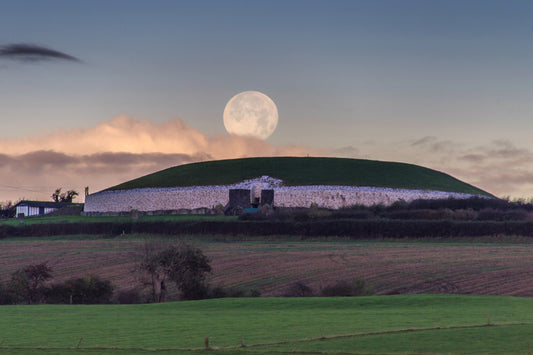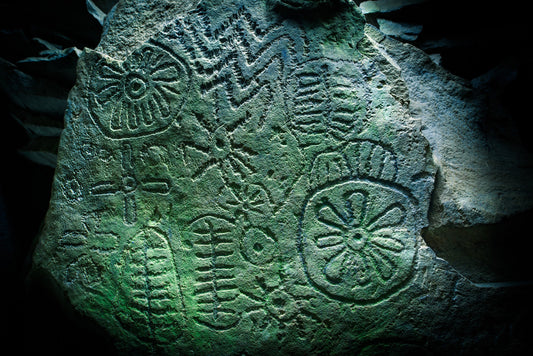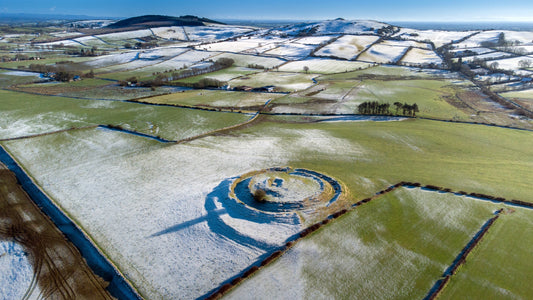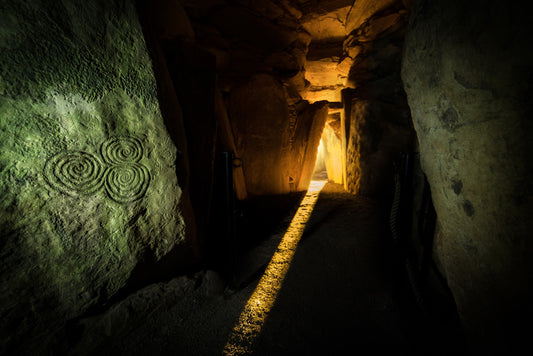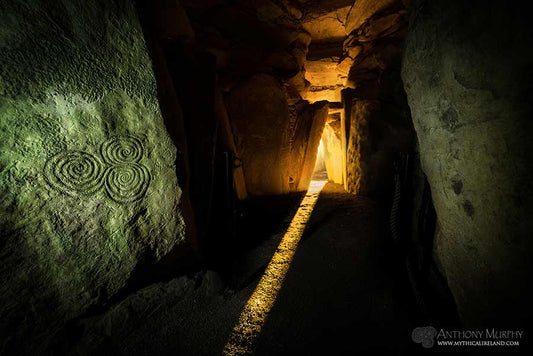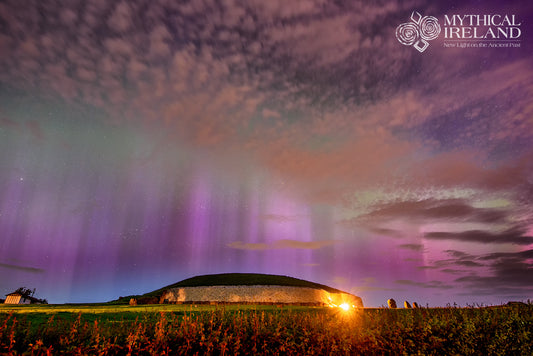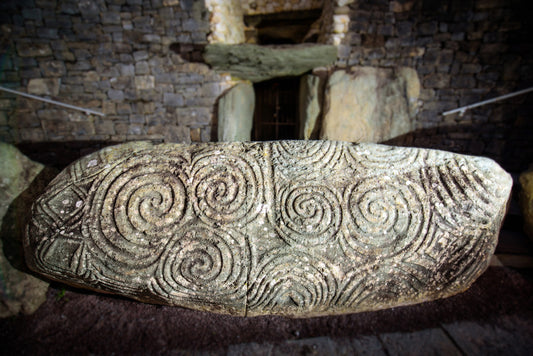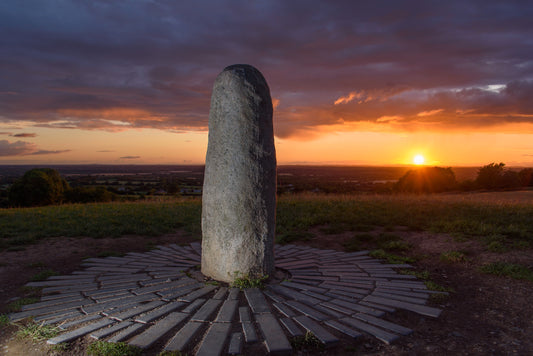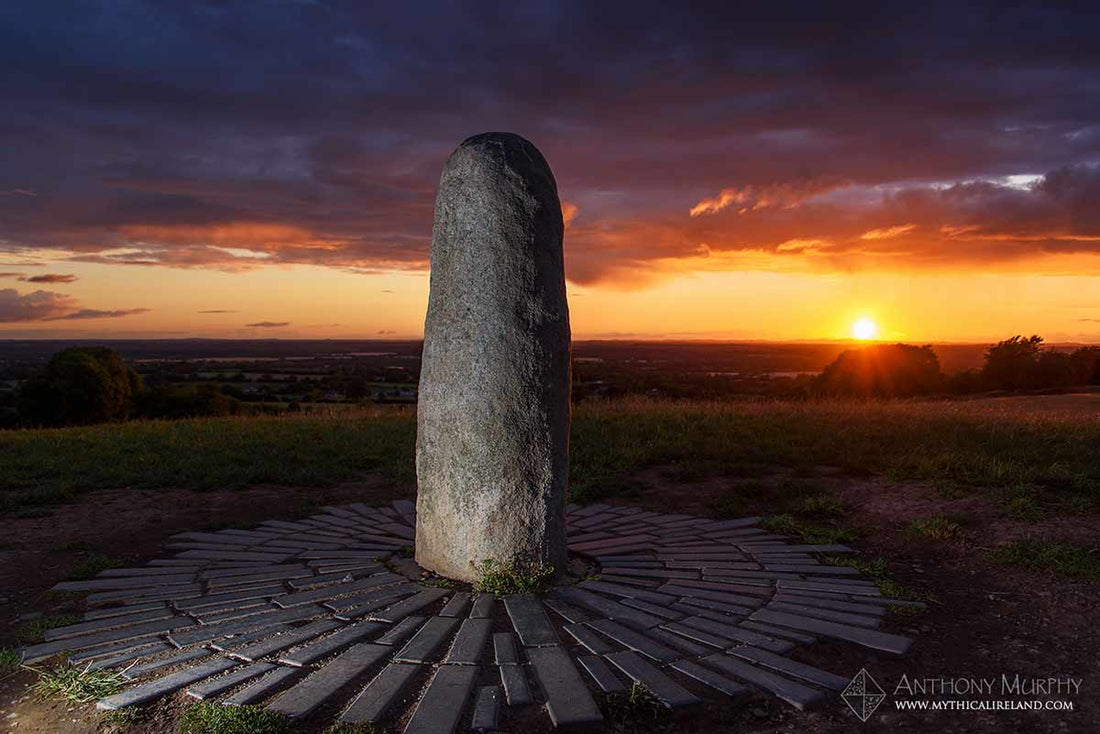
Religion, racism and propaganda: why King Charles III will NOT be crowned on an ancient Irish stone
The story of Ireland’s coronation stone, Lia Fáil (fo-ail, the “under-stone”, i.e. the stone that screamed under the rightful king, also known as the ‘Stone of Destiny’) is so tainted by the nonsense propagated by the British Israelite movement that even today lots of Irish people believe the ‘true’ stone is the one on which King Charles III of Britain will be crowned tomorrow.
So successful were the religious zealots of the 19th century in promulgating the notion that the Stone of Scone (pronounced “scoon”) was, in fact, the ‘real’ Lia Fáil, taken from Ireland, that there are many who doubt the authenticity of the somewhat phallic stone that stands at An Forradh (the ‘Royal Seat’) on the Hill of Tara today.

Lia Fáil under a red sky at the Hill of Tara.
Unfortunately, the situation is not helped by the fact that Lia Fáil was moved to its present position at the Hill of Tara – seat of the High Kings of Ireland in early medieval times – from elsewhere on the hill, and that there is some question about where it was originally located.
The uncertainty about Lia Fáil is further exacerbated by the fact that it is an upright stone, not at all congruent with the notion of a king standing or stepping on it. Many visitors to Tara have noted this curious fact which is at odds with the mythological tradition that the stone screamed when the rightful king placed his foot upon it.

An aerial view of the Hill of Tara.
However, there is no reason to doubt that Lia Fáil at Tara has been on the sacred hill since antiquity. The Dindshenchas (Lore of the Eminent Places), written in the Middle Ages, places it beside Duma na nGiall, the Mound of the Hostages, a Neolithic passage-tomb and the earliest known monument at Tara:
Fál beside the Mound of the Hostages on the north, to wit, the stone that used to roar under the feet of every King that would take possession of Ireland. Of that stone the name was Fál, i.e. fo-ail, “under-stone”, i.e. a stone under a king.[1]
The Lia Fáil was said to have been brought to Ireland by the Tuatha Dé Danann and was one of four talismans or treasures including the Sword of Nuadu, the Spear of Lugh and the Cauldron of the Dagda:
There were four cities in which they [the Tuatha Dé Danann] were acquiring knowledge and science and diabolism: these are their names, Failias, Goirias, Findias, Muirias. From Failias was brought the Lia Fail which is in Temair, and which used to utter a cry under every king that should take Ireland.[2]
The mythological traditions of a sacred stone at Tara are well-established. From an archaeological perspective, the provenance of the upright stone called Lia Fáil standing at Tara today is difficult to determine, principally because we know it was moved in the early 19th century, and there is no certainty about where it was previously located.

A rainbow over the Lia Fáil at the Hill of Tara.
It was placed in its present location in 1821, to commemorate the rebels who had been killed at Tara during the 1798 uprising.[3] George Petrie, a 19th century antiquarian and archaeologist, asserted that it was moved to An Forradh from Duma na nGiall (where the medieval scribes had placed it in their descriptions of the monuments of Tara), but historian Patrick Weston Joyce, writing in 1911, contradicted this claim:
Fifty years ago I had a talk with one of the men who helped in the removal, and I have good reason to believe that the pillar-stone now on the Forradh was brought by the people in 1821, not … from the Mound of Hostages which lies about 50 yards off, but from the bottom of the trench surrounding the Forradh itself, where it had been lying prostrate for generations.[4]

George Petrie. Photo: Royal Irish Academy
The suggestion that the stone had been ‘lying prostrate for generations’ in one of the fosses of An Forradh is intriguing, because this might have been the expected position of a stone on which a prospective king stood, or perhaps stepped on or over, while entering the enclosure that is called the ‘Royal Seat’, thus engaging in an ancient rite involving the crossing of a threshold from the profane to the sacred. However, the fact that the previous position of the stone (before its placement on the Forradh) is disputed only confuses the history of Lia Fáil, and sadly this plays straight into the hands of the British Israelites and those who continue to propagate their grossly distorted beliefs today.
British Israelism
The British Israelite movement was founded in the 19th century, but has its origins in the late 18th century. One of the central beliefs of the British Israelism (which did not consider itself a religious sect, but clearly was an organisation inspired by religion) was ‘that the Anglo-Saxon race was descended from the Lost Tribes of Israel’.[5]
They believed that the Lia Fáil of Tara was, in fact, brought to Ireland by the Biblical patriarch Jeremiah, and that it may even have been Jacob’s Pillow – all nonsense, of course,[6] but through all manner of spurious and questionable interpretations of Biblical passages, and ‘etymological gymnastics’,[7] they were able to convince at least their own adherents (and, sadly, a cohort of others) that Jeremiah had come to Ireland with a remnant of the Israelite people, bringing Jacob’s Pillow to Tara for the purpose of ‘establishing a royal line’.[8] Another untruth propagated by British Israelism is that Jeremiah is the ‘Ollamh Fodla’ (who was, according to medieval Irish tradition, a High King of Ireland), and that Cairn T – a Neolithic passage-tomb at Slieve na Calliagh, Loughcrew, Co. Meath – is not really a Stone Age burial tomb but one built around the 6th century BC to house the remains of Jeremiah.[9]

British Israelites would have us believe this Neolithic tomb (Cairn T) is the burial place of the Old Testament prophet Jeremiah.
The Dindshenchas lore of Tara says that the sacred hill was named after a mysterious princess called Tea Tephi, who had come to Ireland from Thebes. She married Éremon, a son of king Mil of Spain and the first of the Gaelic kings of Ireland. The Metrical Dindshenchas says she was the daughter of a Pharaoh.[10]
The British-Israelites, not afraid to concoct alternative and quite fantastic scenarios from myth and scripture, claimed that Tea had in fact arrived in Ireland with ‘a party of Hebrews at around the time of the Babylonian captivity’[11] and they concluded that she was, in fact, the daughter of Zedekiah, the last king of Judah and the last king in the line of David.[12] You couldn’t make it up!
Their intention here was to provide a quasi-credible genealogy linking the British monarchy to the ancient royal lineage of David. Why would they do that? One line of thought is that a royal link to Judah and the Lost Tribes would somehow substantiate or legitimise any British involvement in the campaign to establish a permanent homeland for the Jewish people in the lands of Palestine. (The Balfour Declaration, in which Britain affirmed its support for a Jewish nation in Palestine, was issued in November 1917).
Perhaps the most damaging of all the tenets of British-Israelism, and one that left an indelible mark on the landscape of Tara, was their belief that the Biblical Ark of the Covenant was, in fact, buried beneath the soil of the Hill of Tara.
They believed this with such conviction that, with the permission of the then landowner, Gustavus Villiers Briscoe, a group of would-be archaeologists began digging at Ráth na Seanad (Rath of the Synods) in the summer of 1899 looking for the lost Ark.

British Israelite excavations caused major damage at Ráth na Seanad.
They never found it, of course, but their sloppy, unprofessional and totally misguided work had the dual effect of practically destroying the quadrivallate enclosure that was Ráth na Seanad while also raising the ire of Irish nationalists and patriots, leading to a very vocal and public campaign against the ‘excavations’, headed by such figures as Maud Gonne and Arthur Griffith.
Contemporary newspaper reports of the excavations varied in their tone according to whether they had a nationalist/Catholic or unionist/Protestant readership. Griffith’s United Irishman newspaper was particularly vocal against the vandalism of Tara, as was the Drogheda Independent.
RAS Macalister, a well-known archaeologist of the early 20th century, described British Israelism as ‘an abortion begotten of unscholarly ignorance of the nature of the Biblical historical record, upon unbridled national bumptiousness’.[13]
Thankfully, the disastrous excavations at Tara were brought to an end by a high-profile campaign of protest led by Gonne, Griffith, and others including Douglas Hyde, the poet W.B. Yeats and George Moore.
However, British Israelism survives today, and in recent decades one individual who promotes a lot of the nonsense of that movement (which is now largely defunct, thankfully) even petitioned the Irish Government to allow him to dig at the Hill of Tara because the true location of the Ark’s resting place had been revealed to him!

Lia Fáil has been vandalised several times.
As to the Lia Fáil, the stone that still stands at Tara today, it has sadly been the subject of vandalism in recent years. In February of this year, the word “FAKE” was spray-painted on the stone a number of times. In 2012, someone took an axe to it and chipped several pieces of the stone off. In 2014, someone tipped a bucket of paint over it.[14]
These attacks are likely motivated by religious beliefs and British-Israelite propaganda. In the eyes of the religious zealots, because this stone looks like a penis, and thus is an overtly ‘pagan’ idol, it could not possibly be the true Stone of Destiny, the one that the British Israelites claim was originally Jacob’s Pillow, brought to Ireland by Jeremiah.
Could the real Stone of Destiny please stand up
The ‘real’ Stone of Destiny, they say, was removed from Tara by St. Columba and taken to Iona. From there, it had been removed to Dunstaffnage Castle in Scotland in 487AD by Fergus More, and, if you believe the wild fabrications of the British Israelites, it was later removed in 840AD to the Palace of Scone, where it became the seat of the Scottish kings. That stone is transported to Westminster for the inauguration of the British royals and will be used during the coronation of Charles III. However, that stone is NOT the Lia Fáil of Tara. A recent scientific examination of the Stone of Scone revealed that its geological features ‘match those found at the Scone Sandstone Formation in central Scotland’.[15] The Lia Fáil at Tara is made of granite, while the bedrock of the Holy Land (from where a Jacob’s Pillow was allegedly brought) is limestone.
However, P.W. Joyce tells us that ‘the story of the removal of the Lia Fail to Scotland rests entirely on the authority of the Scottish historians’.[16] Importantly, he adds that Geoffrey Keating, writing his history of Ireland in the 17th century, relied on later Scottish chronicles ‘now universally rejected as fable’, and that ‘in no Irish authority before the time of Keating is there any mention of either the removal of the stone, or of the prophecy concerning it’.[17]
‘The story of its removal [from Ireland] has been examined by Dr. Petrie, who shows that it is flatly contradicted by native Irish authorities; that it is nothing better than a fabrication; and that Lia Fail was never moved from Tara at all.’[18]
Joyce concluded three things from his investigation of the story of the Lia Fáil:
- The stone now under the Coronation chair at Westminster is the very one brought from Scone in the thirteenth century, but it is not the Lia Fail.
- The present massive pillar-stone on the Forradh at Tara is not the Lia Fail.
- The Lia Fail was never brought away from Ireland, but remains still in Tara, buried and hidden somewhere in the soil; probably in the position where the old writers place it, on the north side of the Mound of Hostages.[19]
Sadly, the uncertainty surrounding the stone popularly called Lia Fáil standing at Tara today only obfuscates the whole matter. Nevertheless, the notion that the stone used in the coronation of Charles III and previous British monarchs was once at Tara, and that it had been brought to Tara by Jeremiah, and that it was once Jacob’s Pillow, is the stuff of fiction and fantasy.
Hijacking Irish myth and history
British Israelite dialogue pertaining to Ollamh Fodla being the Bible prophet Jeremiah, and their claims that Tara is the location of the Ark of the Covenant, and their more-than-dubious proposition that the British Royal family’s descent from the line of David can be traced through Irish myth is nothing more than Anglo-Saxon white supremacist claptrap and propaganda that attempts to completely hijack and appropriate Irish Irish history and mythology in support of the wild claim that the British royals are David’s descendants.
One British-Israelite commentator, Reverend F.R.A. Glover, asserted about Lia Fáil that ‘all the armaments of the world shall not wrest it from the grip of the Anglo-Saxon’.[20] It’s a pity for him that the Hill of Tara has now wholly Irish, and that it has indeed been wrested from the grip of the Anglo-Saxon. However, its story has been considerably tainted by the disinformation which his organisation circulated, deception that is sadly still believed by a cohort of Irish people today.
The fact that this entire fabrication is indeed a form of white supremacist, racist propaganda is demonstrated by the belief among some modern adherents of British Israelism that the Irish are descended from the Tribe of Dan – one of the original 12 Tribes of Israel that won’t, according to the Book of Revelation, be sealed for deliverance in the final days. There is also a belief that the Antichrist will emerge from the descendants of Dan – a fitting narrative for anyone wishing to use the Irish as a scapegoat for the past atrocities of imperial Britain.

King Charles III. Photo: royal.uk
Charles III may well be installed upon a throne beneath which a ‘Stone of Destiny’ will be placed, and that stone is likely to be the original Stone of Scone. However, the stone upon which he will be installed is NOT the Lia Fáil of Tara, County Meath, Ireland.
Let’s put to rest once and for all this distortion of myth, history and scripture which is, at best fallacious, and at worst a form of modern white supremacist propaganda and absurdity serving no purpose other than to perpetuate division and conflict based on racial, religious and nationalist ideals.
We’ve had enough of all that stuff. It’s time to move on.
References
[1] Rennes Dindshenchas, translated by Whitley Stokes. See Revue Celtique Vol. XV, 1894, p. 285.
[2] Lebor Gabála Érenn, The Book of the Taking of Ireland, Part IV, translated by R.A.S. Macalister, Irish Texts Society (1941)[2009], p. 107.
[3] P.W. Joyce, The Wonders of Ireland, 1911, p. 69.
[4] Ibid., p. 70.
[5] Mairéad Carew, Tara and the Ark of the Covenant, The Royal Irish Academy, 2003, p. 11.
[6] The Lia Fáil at Tara is made of granite. The bedrock of the Holy Land is of limestone. See: https://www.nationalgeographic.com/travel/article/stone-of-scone-british-coronation
[7] Ibid, p. 27.
[8] Ibid, p. 26.
[9] This notion is still propagated by modern proponents of British Israelism and unfortunately still has, along with several other tenets of that movement, a fringe following in Ireland.
[10] Metrical Dindshenchas, Part I, translated by Edward Gwynn, Todd Lecture Series, Royal Irish Academy, 1903, p. 7.
[11] Carew, op. cit., p. 25.
[12] Ibid.
[13] Ibid., p. 29.
[14] https://www.newstalk.com/news/lia-fail-why-the-penis-stone-is-such-a-target-1436054
[15] https://www.archaeology.org/news/11414-230503-scotland-royal-stone
[16] Joyce, op. cit., p. 66.
[17] Ibid, pp. 66-67.
[18] Ibid, op. cit., p. 65.
[19] Ibid,. p. 71. No trace of such a stone was found during 20th century excavations of Duma na nGiall (Mound of the Hostages).
[20] Carew, op. cit., p. 27.

